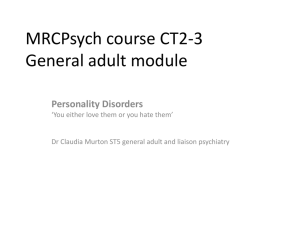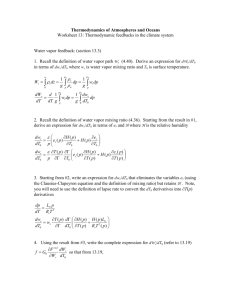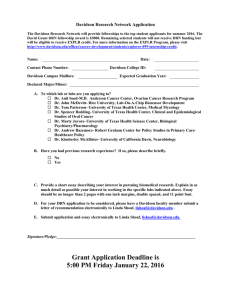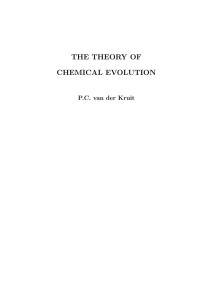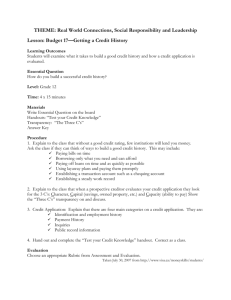DRN Guide to a Debt Relief Notice Se
advertisement
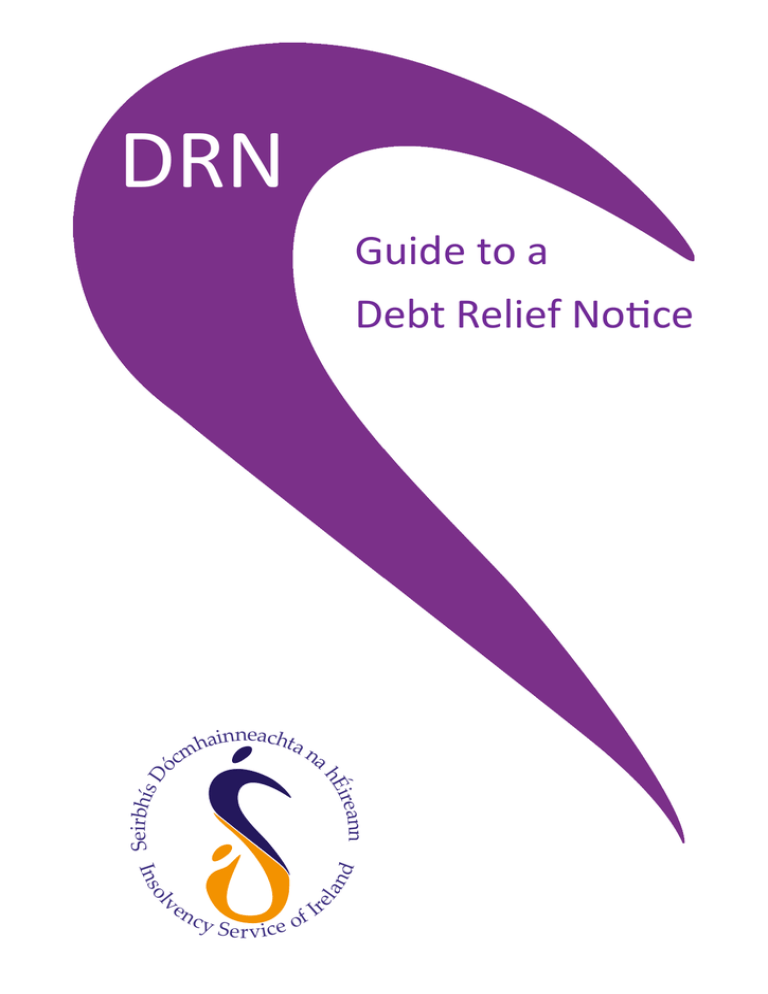
DRN ainneachta h na cm nc Ir el ol ve an In s d n irean hÉ Seirbhís Dó Guide to a Debt Relief Notice y S e r v i c e of A Debt Relief Notice enables an eligible insolvent debtor with limited disposable income and assets to write off his or her qualifying debts of up to €20,000 in circumstances where he/she is insolvent and it is unlikely that his/her financial situation will improve in the next 3 years. DISCLAIMER This guide has been produced by the Insolvency Service of Ireland (ISI) and is intended as a general, introductory, non-technical guide for interested debtors in relation to the availability of, and the process involved in seeking a Debt Relief Notice under the Personal Insolvency Act 2012. If, after reading this guide, you require further information of a general nature, please consult the ISI website, www.isi.gov.ie, or contact the ISI’s office by the various means detailed on the inside back cover of this guide. The ISI has no role in providing legal advice or interpreting the law and this guide is not an interpretation of, or advice on the law. In addition, the ISI has no role in providing financial advice. If you are in doubt in relation to your legal or financial position, please take appropriate professional advice or contact an Authorised Intermediary, as appropriate. Date of publication: March 2013 Contents Part 1 Background Information 1. Introduction . . 2. About this guide 3. What is a DRN? . . . . . . . . . . . . 3 . . . . . . . . . . . . . 4 . . . . . . . . . . . . . 4 4. Who is eligible to seek a DRN? . . . . . . . . . 5 What type of debt may/may not be included in a DRN? (Illustration) 5. How to seek a DRN and who will deal with your case? Debtor Journey – Step by Step (Illustration) . . . 7 . . 8 Part 2 The Process 6. Debtor journey—step by step . . . . . . . . . 9 7. How will participating in a DRN affect you? . . . . . 13 Will details of your DRN be published anywhere? What happens if you seek to obtain credit from someone while you are subject to a DRN? . . . . 13 . . 13 Will entering into a DRN affect your employment? What happens to your vehicle? . . . . . . . 14 . 14 What happens to your pension? . . . . . . . 14 What happens if your circumstances change? . . . 14 Part 3 Supplementary Information 8. Related Insolvency Service of Ireland publications . . . 15 9. How to make a complaint . . . . . . . . . . 15 10. Data Protection . . . . . . . . . . 15 . . . Key features of a DRN Part 1 Background Information 1. Introduction The role of the Insolvency Service of Ireland (ISI) is to restore insolvent debtors to solvency in a fair, transparent and equitable way. The Personal Insolvency Act 2012 (“the Act”) continues the reform of the Bankruptcy Act 1988 and includes the introduction of an automatic discharge from bankruptcy after three years, subject to certain conditions. It also introduces three alternatives to bankruptcy (“new arrangements”), of which a Debt Relief Notice (DRN) is one. The ISI believes the new arrangements will play an important part in addressing difficulties currently faced by many insolvent debtors and their creditors by enabling resolution of over-indebtedness in an orderly and rational manner without recourse to bankruptcy. It is important for debtors and creditors to be fully informed of the consequences of entering into one of these arrangements and any alternative options they may have before so doing, including voluntary agreements outside the Act. In operating the new arrangements, it is important for all stakeholders involved in them to adhere to the principle of fairness. A fair balance must always be struck between the interests of the debtor and his or her creditors. While no creditor should be unfairly prejudiced, it is also hoped that creditors will fully engage in the new arrangements. A debtor who fully complies with one of the new arrangements will return to solvency - this outcome is in the best interest of all concerned. 3 2. About this guide This guide is published by the ISI. The ISI was established to administer certain measures under the Act. If a debtor cannot pay his/her debts in full as they fall due, then he/she is insolvent. A Debt Relief Notice (DRN) is one of several potential solutions that a debtor may be able to avail of to address his/her financial difficulties. This guide gives an overview of the process involved in applying for and obtaining a DRN. If you are thinking of seeking a DRN, you should consult an Approved Intermediary (AI) such as certain personnel at the Money Advice and Budgeting Service who have been authorised to operate as AIs. Further details are available on their website www.mabs.ie. This guide outlines what you need to consider before you decide to apply for a DRN. You should read it carefully and seek further information and advice if necessary. There may be other solutions to your debt situation. You should explore the alternatives to a DRN as soon as possible in case they are more suitable for your particular situation. More details of the legislation, the new insolvency arrangements, the work of the ISI and a list of AIs are available on the ISI website www.isi.gov.ie 3. What is a DRN? The Act makes provision for the issue of a Debt Relief Notice (DRN) in certain circumstances. Its purpose is to give relief from debt to people who are in debt and have little or no disposable income or assets which they could use to repay what they owe. The qualifying debts they owe cannot exceed €20,000. The DRN process enables eligible insolvent debtors to write off their debts where they can prove they are not in a position to repay them and it is unlikely their financial situation will improve in the next 3 years. 4 4. Who is eligible to seek a DRN? A DRN is not suitable for, or available to, every debtor. There may be other options open to an insolvent debtor depending on their circumstances. You are only eligible to seek a DRN if you meet the general conditions set out below: You are insolvent in that you are unable to pay your debts in full as they fall due and there is no likelihood of you doing so within 3 years; You have a net monthly disposable income of €60 or less after reasonable living expenses (which will be calculated by the AI on a case by case basis using a standard template); You owe €20,000 or less in respect of your qualifying debts; You have assets of €400 or less (you are also allowed 1 item of jewellery not exceeding a value of €750, one motor vehicle worth a value of €2,000 or less and reasonably necessary household equipment/tools the combined value of which may not exceed €6,000); Your domicile must be in the Republic of Ireland, or you must have, within the past year ordinarily resided or had a place of business within the Republic of Ireland; You have completed and signed a Prescribed Financial Statement (PFS) and made a Statutory Declaration that it is true and accurate; You must not have incurred 25% or more of your debt during the past 6 months; You have not had a DRN previously; You must not be the subject of a Debt Settlement Arrangement (DSA) or Personal Insolvency Arrangement (PIA) now or within the past 5 years; You must not have been the subject of a Protective Certificate issued in respect of a DSA or a PIA within the past year; You have not entered into certain transactions at less than market value in the past 2 years; You have not given certain preferential treatment to one creditor over another in the past 2 years (e.g. paying off a family member before your bank or credit union); You must not be bankrupt or subject to a bankruptcy measure or have been discharged from bankruptcy in the past 5 years. An AI has signed a statement of satisfaction as to your eligibility and the truth and accuracy of your PFS. 5 What type of debt may/may not be included in a DRN? May be included Requires consent of creditors to be included* “Excludable Debts” • • • • • • Credit card debt Overdrafts Personal Loans Credit Union Loans Utility bills Store cards • Taxes, duties, levies owed or payable to the State • Local government charges • Amounts due to the Health Service Executive under the Nursing Home Support Scheme • Annual service charges to owner’s management companies (apartments and housing estates) • Liabilities arising under the Social Welfare Consolidation Act 2005 • Local authority rates • Household charges • Family maintenance payments under Court orders Cannot be included “Excluded Debts” This list is not exhaustive, if you are unsure if your debt can be included in a DRN talk to an Authorised Intermediary *Creditor consent to include debt may be requested in which case it becomes a permitted debt. If no response is received the creditor will be deemed to have consented. 6 • Court fines in respect of criminal offences • Liabilities arising out of personal injury or wrongful death claims awarded by the Court • Liabilities arising from loans obtained by fraud 5. How to seek a DRN and who will deal with your case? You can only seek a DRN via an AI who will act on your behalf during the application process. The ISI will maintain a list of AIs on the ISI website www.isi. gov.ie. Part 2 of this guidebook outlines the detailed steps involved in the DRN process. The AI will talk to you about your financial situation and eligibility and how a DRN is likely to affect you if you are granted one. In order to be considered for a DRN you will need to give full and accurate details of your financial situation, setting out details of all of your debts, assets, liabilities, income, etc. While this may seem overwhelming, you should bear in mind that the purpose of a DRN is to help you recover from your financial difficulties and the role of the AI is to help you to make the process as straightforward as possible. If you decide to proceed with an application for a DRN, you will be required to give written consent for the ISI to access your personal data. A full list of the consents you are required to give are set out under Part 2 of this guide. Note—the ISI will charge an application fee for a DRN. However, an AI cannot charge you for their involvement in the process. Further details are available on the ISI website, www.isi.gov.ie If you participate in the DRN process, you will at all times be under a statutory duty to act in good faith and to cooperate fully in the process. 7 Part 2 The Process Applying • Meet with AI and give an overview of your financial situation. • If you are eligible and wish to apply for a DRN confirm this in writing to the AI. • Gather the relevant documents and fill out forms. • AI will send application on your behalf to the ISI. • If all is in order your application will be sent to Court and the Court will issue a DRN. • The ISI enters details of your DRN on a public Register when it is granted. Complying • You can exit a DRN at any stage by paying 50% of the amount owed to the creditors specified in the DRN. • If you comply with the terms of the DRN the debts specified in it will be written off at the end of a 3 year supervision period. • If the DRN is successfully completed, the entry on the public Register in respect of the DRN will be removed. Completing 8 • You must provide all relevant information to the AI. • You must act in good faith and be honest in your application. • You must comply with requests for any further information required. • Your DRN will be subject to a 3 year supervision period. • If your circumstances change during the 3 years you must inform the ISI. • If you apply for credit over €650 during the 3 year supervision period you must tell the creditor you are subject to a DRN. 6. Debtor journey—step by step The following steps set out the process in more detail. STEP 1: Applying for a DRN • If you are struggling with your debts and think you might be eligible for a DRN based on the conditions set out in this guide you should contact an AI to get further information as to your eligibility status for a DRN and what’s involved in the DRN process. • If you decide you would like to apply for a DRN you will need to give the AI full details of your financial situation. The AI will discuss your situation with you and let you know if, in principle, you are eligible to apply for a DRN based on the information you have supplied. • The AI will talk you through the DRN application process and he/she will outline your duties and obligations. You can expect to receive written advice on whether or not the AI is of the view that the DRN is the best insolvency arrangement for you and the reasons for that opinion. Where applicable, the AI will advise you on what other debt management or resolution option might suit your particular circumstances. • Having regard to the advice received from the AI, if you are happy to go ahead with an application for a DRN you will be asked to confirm in writing that you want to proceed and request the AI to act on your behalf. You can withdraw your application at any point prior to the issue of a DRN. • You can expect to have a meeting/series of meetings and/or phone calls with the AI to enable you to progress your application. • You will be required to complete a Prescribed Financial Statement (PFS), with the assistance of the AI. This is a detailed electronic form that is designed to capture all key financial information about you. You will also be required to give supporting documentation and proof of your financial situation (e.g. up to date statements, bills, etc). • The AI will examine your completed PFS. If he/she is satisfied that the PFS is true and accurate and that you satisfy the eligibility criteria, he/she will prepare a statement to that effect. 9 • You are required to sign a statutory declaration (in the presence of a witness authorised to witness such declarations—such as a practising solicitor, Peace Commissioner, Commissioner for Oaths or Notary Public) affirming that the PFS is a complete and accurate statement of your assets, liabilities, income and expenditure. • You will be asked to complete and sign some documents to accompany your application. Your application must be accompanied by: 1. a copy of the statement made by the AI referred to above; 2. a document signed by you confirming that you satisfy the eligibility criteria for a DRN; 3. a completed PFS form and statutory declaration; 4. a schedule of your creditors and amount owed to each; whether the creditor is a secured creditor or not (if so, you must provide details of any security); where a debt is an excludable debt you must state if it is a permitted debt; (see page 6) 5. Your written consent to enable; • the AI to disclose your personal data to the ISI; • the ISI to process your application; • the ISI to make any necessary enquiries about you; and • the ISI to disclose your personal data to the creditors concerned, as required. 6. A document signed by you stating whether you are aware of any judgement or Court order in force against you which relates to any of your debts which are included in the DRN. • The AI will then submit your completed application to the ISI for consideration. If all information is in order, the ISI will then forward your application to the Circuit Court. • If the Court approves your application, it will issue a DRN. The ISI will notify you, your creditor(s) and the AI of the issue of the DRN. From the date of issue of that DRN there will be a 3 year supervision period. During that time the creditor(s) listed in your DRN cannot pursue you for the debts you owe them that are specified in the DRN. This does not apply to secured creditors. However, creditors are entitled to appeal their inclusion in a DRN where 10 they feel they are within their rights to do so. • If you are granted a DRN your details will be placed on an electronic public Register of Debt Relief Notices. You should be aware that under the Act, it is a criminal offence to knowingly or recklessly give information which is false or misleading in your application for a DRN. STEP 2: Complying with the terms of a DRN • You must act in good faith at all times during your application and supervision period. • You must inform the ISI should your circumstances change materially, as this may create an obligation for you to repay some of the debts included in the DRN. • You must inform the ISI where: • your monthly net income increases by €400 or more; or • you receive a gift or sum of money of €500 or more; in both cases 50% must be surrendered to the ISI for the benefit of your creditors. • You can make payment(s) to the ISI at any stage during the supervision period of your DRN and the ISI will distribute the payment(s) to your creditor(s) accordingly. • You can discharge yourself from the DRN at any stage of the process by making a payment to the ISI of 50% or more of the total amount owed to the creditor(s) specified in your DRN. • If you do not comply with the agreed terms of the DRN or if it emerges that you were not truthful or complete in the disclosure of information in the PFS, the DRN will be terminated and you will revert to owing the full amount that you owed prior to entering into the DRN agreement including any interest accrued. • During the supervision period the ISI can apply to the appropriate Court to have a DRN amended (for technical reasons) or terminated, as appropriate. 11 STEP 3: Completing a DRN • Subject to the Act, at the end of the 3 year supervision period, all debts listed in the DRN will be written off in full. • Details of the DRN will also be removed from the public Register for Debt Relief Notices and creditors will be notified of that fact. • The ISI will issue a Debt Relief Certificate to you confirming your discharge from your debts listed in the DRN. • You will now be solvent. You must inform the ISI where you become aware of any inaccuracy or omission in your PFS, documents or other information provided with your application for a DRN. 12 7. How will participating in a DRN affect you? One of the main effects of obtaining a DRN is that it creates a ‘moratorium’ period of 3 years (although there are exceptions whereby this may be extended) during which time creditors cannot take any action to try to recover or enforce their debts listed in the DRN. During the period of your DRN, you are not required to make any direct payments to the creditors in respect of debts that are included in the DRN, provided you comply with the Act and your circumstances do not change as indicated elsewhere in this guide. After the 3 year period, provided you have complied with the Act, the listed debts specified in the DRN will be written off in full. Will details of your DRN be published anywhere? Should you enter into a DRN, your details (name, address, date of birth, date of issue of DRN and any other information the ISI deems relevant) will be placed on an electronic public Register of Debt Relief Notices. This will remain in place for the 3 year supervision period that follows the issue of the DRN. Members of the public can inspect the Register and request copies of entries contained on that Register. Therefore, if you seek credit while your details are on the Register, the creditor is likely to check the Register before approving your application. However, upon successful completion of the DRN or if you make a payment of 50% or more of the debts contained in the DRN your details will be removed from the Register. What happens if you seek to obtain credit from someone while you are subject to a DRN? If you seek to obtain credit of an amount of more than €650 during the supervision period of 3 years, you must inform the creditor that you are a specified debtor, subject to a DRN. You should be aware that factors such as the entry of your details on the Register for DRNs may be relevant to your credit rating and influence any information about you held by rating reference agencies such as the Irish Credit Bureau (or the Central Credit Register). 13 Lenders retain the right to take into account a debtor’s credit history in assessing the merits of a credit application. This means you may find it more difficult to get credit in the future. Will entering into a DRN affect your employment? The Act does not require that a person’s employment be affected, however, certain professions may be governed by bodies where members’ personal finances are subject to regulatory requirements. What happens to your home? The Act does not impose any requirements on you with respect to your home. What happens to your vehicle? You are entitled to keep your vehicle if it is not valued at more than €2,000. There are exceptional circumstances where you may be eligible to keep a vehicle of higher value than €2,000 e.g. where you or a dependent has a disability and your vehicle has been modified for use in that regard. What happens to your pension? Any pension arrangements you have will be taken into account at application stage when the AI is considering your eligibility for a DRN. However, if you are deemed to be eligible and receive a DRN, the arrangement will have no further effect on your pension – unless your pension income increases during the supervision period, see below. What happens if your circumstances change? If your material circumstances change during the 3 year period of your DRN you must inform the ISI. You must advise the ISI in circumstances where, during your supervision period: • your net income increases by €400 or more per month; or • you receive a gift or sum of €500 or more. In both cases you are obligated to submit 50% to ISI for distribution to creditor(s). 14 Part 3 Supplementary Information 8. Related Insolvency Service of Ireland publications Other relevant publications are available on the ISI website www.isi.gov.ie. A number of scenarios are also available on the website indicating the possible outcome of a DRN application for a given set of circumstances. You will also find information on www.mabs.ie. 9. How to make a complaint If you are unhappy with the way your case has been handled by the ISI or AI it is within your rights to make a complaint. See the separate information document ‘Complaints Procedures’ for further details. 10. Data Protection If you apply for a DRN you will have to provide written consent for the ISI to access your personal data, as appropriate. You should note that if you successfully obtain a DRN: • your information will be placed on a public Register; and • your creditors will receive a copy of your Prescribed Financial Statement. The ISI will comply with the Data Protection Act of 1988 and the Data Protection (Amendment) Act of 2003 except where it is exempted in the case of an investigation process. 15 10.Glossary of terms “The Act” Personal Insolvency Act 2012. Approved Intermediaries Approved Intermediaries (AIs) are certain people who have been approved by the Insolvency Service of Ireland to act on the debtor’s behalf as intermediaries in the DRN process. A list of AIs is available on the website. Asset A possession that has some monetary value or can produce a cash flow. An asset can therefore be used to discharge debts. Bankruptcy Bankruptcy is ‘an option of last resort’. It is a personal insolvency process available under the Bankruptcy Act 1988, as amended, where a person cannot pay his/her debts. In most cases, once a person has been made bankrupt, an official (the “Official Assignee”) takes control of the person’s property and realises that property to discharge debts of the bankrupt. Creditor A person who is owed money by a debtor. Debt Debt is money that a person must repay. Debt for the purpose of a DRN is an amount that is certain and not contingent on the occurrence of some event such as a guarantee being called or payable either immediately or within 3 years. Debtor A person who owes money (a debt) to a creditor. Debt Relief Notice (DRN) A DRN is a personal insolvency measure provided for under the Act which covers debts up to €20,000 but certain restrictions apply. 16 Debt Settlement Arrangement (DSA) A DSA is a personal insolvency measure provided for under the Act which does not cover secured debts. Insolvency Service of Ireland (ISI) The ISI is the statutory body established under the Act, which is responsible for, amongst other things, monitoring the operation of the arrangements relating to personal insolvency provided for in the Act; considering applications for Debt Relief Notices; the authorisation of Approved Intermediaries and certain other functions specified in the Act. Insolvent A person is insolvent if they are unable to pay their debts in full as they fall due. New arrangements “New arrangements” refers to the three new measures under the Act—the Debt Relief Notice; Debt Settlement Arrangement and Personal Insolvency Arrangement. Personal Insolvency Arrangement (PIA) A PIA is a personal insolvency measure provided for under the Act which covers both unsecured and secured debts. Prescribed Financial Statement (PFS) A statement in prescribed form of the debtor’s full financial position detailing his or her income, expenditure, assets and liabilities. A PFS will form part of any application by a debtor for one of the new arrangements. Secured creditor A creditor who holds a specific claim (usually a property interest) over one or more of a debtor’s assets as security for a secured debt. An example would be a mortgage or charge over a house. Secured debt A debt backed or secured by an asset to reduce the risk associated with the debt by use of arrangements which make the asset available to the secured creditor to discharge the debt before general/unsecured creditors (e.g. a mortgage or charge over a house used as security for a housing loan. If the debtor defaults or fails to meet one of the terms of repayment, the bank may 17 seize his/her house to sell, using the proceeds towards the settlement of outstanding debts). Statutory declaration A written, signed and witnessed statement which allows a person to formally affirm something to be true before a person that is authorised to witness them (such as a practising solicitor) in accordance with the Statutory Declarations Act 1938. A statutory declaration will form part of any application by a debtor for one of the new arrangements. Unsecured creditor A creditor who does not have a specific claim (usually a property interest) over the debtor’s assets. Unsecured debt A debt where the unsecured creditor would not be entitled to seize specific assets if the debtor fails to make repayments because that creditor does not hold security over those assets. The Insolvency Service of Ireland's objective is to restore people who are insolvent to solvency in a fair, transparent and equitable way. Insolvency Service of Ireland Phoenix House Conyngham Road Dublin 8 Phone: 0761 064 200 Email: drn@isi.gov.ie Website: www.isi.gov.ie 18 Key features of a DRN • A Debt Relief Notice (DRN) is an insolvency measure for people who have qualifying debts not exceeding €20,000 and who have limited income and assets. • A DRN can include secured and unsecured debts. • A DRN lasts up to 3 years. • A DRN can only be obtained once in a lifetime. • A DRN can only be sought through an Approved Intermediary (AI). • A DRN will protect a debtor from legal proceedings and other actions by creditor(s) during its validity period. However, a secured creditor’s right to enforce security will not be affected by a DRN. • A DRN which is successfully completed will discharge the debtor from his/her debts that are specified in the DRN at the end of a 3 year supervision period. • If a debtor successfully obtains a DRN, his/her details will be placed on a public Register of Debt Relief Notices. • A debtor will have his/her details removed from the Register where (a) he/she is discharged from his/her debts that are specified in the DRN by paying 50% or more of the debts owed during a 3 year supervision period or (b) where the debtor complies with his/her statutory obligations during the 3 year supervision period and is then discharged from his/her debt.
